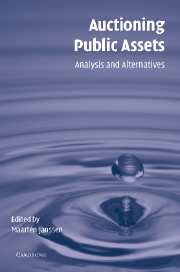Book contents
- Frontmatter
- Contents
- List of figures
- List of tables
- List of contributors
- Preface
- Introduction
- Part I Theory
- Part II Case studies
- 6 Spectrum auctions by the United States Federal Communications Commission
- 7 An analysis of the European 3G licensing process
- 8 Auctions of gas transmission access: the British experience
- 9 The design of Treasury bond auctions: some case studies
- 10 Matching markets
- 11 Competitive procurement of reintegration services in the Netherlands
- 12 The provision of rail services
- Index
- References
7 - An analysis of the European 3G licensing process
Published online by Cambridge University Press: 03 December 2009
- Frontmatter
- Contents
- List of figures
- List of tables
- List of contributors
- Preface
- Introduction
- Part I Theory
- Part II Case studies
- 6 Spectrum auctions by the United States Federal Communications Commission
- 7 An analysis of the European 3G licensing process
- 8 Auctions of gas transmission access: the British experience
- 9 The design of Treasury bond auctions: some case studies
- 10 Matching markets
- 11 Competitive procurement of reintegration services in the Netherlands
- 12 The provision of rail services
- Index
- References
Summary
Introduction
In the years 2000 and 2001, several European countries issued licences for third-generation (3G) mobile telecommunications, usually referred to as UMTS. In the context of the present book, where auction methods are analysed and compared to their alternatives, the UMTS case is of particular interest since it is one of the few cases in which countries have chosen different allocation mechanisms to allocate similar goods. Several papers have already been written on the European 3G licensing process. This chapter is structured around the two main research questions of the present book, namely:
What mechanisms can be used to allocate rights to operate in a market, and under what set of circumstances should one allocation mechanism be preferred over others?
What are the important design issues once a particular mechanism is chosen?
Section 2 addresses the first question. It categorises the different allocation mechanisms used by European countries and offers a comparative analysis. It is important to note at the outset that the usual distinction between auctions and Beauty Contests is too simplistic. Section 3 addresses the second main research question. It offers a general survey of the main issues pertaining to efficiency and revenue maximisation in licence auctions. In section 4, we look in more detail at the most flexible design – the German (and Austrian) one. Section 5 concludes.
Licensing methods
In the recent allocations of spectrum for UMTS mobile telephone services, European governments had to make decisions on two main issues:
How many licences should be awarded, and with what spectrum capacity?
[…]
- Type
- Chapter
- Information
- Auctioning Public AssetsAnalysis and Alternatives, pp. 177 - 196Publisher: Cambridge University PressPrint publication year: 2004
References
- 2
- Cited by



